AI Research
GPs are using artificial intelligence to record patient consultations but how safe is your personal data?
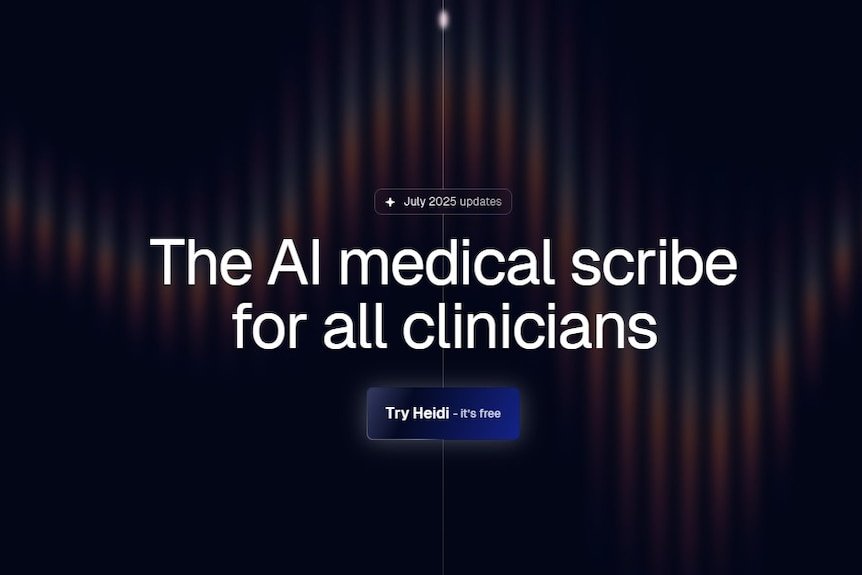
For the last 12 months Dr Grant Blashki has used what he calls a “medical intern” in every appointment.
His intern is completely digital. It is an artificial intelligence scribe that listens to every word his patients say.
“It’s mostly surprisingly accurate,” the GP told 7.30.
“Occasionally it will mishear the name of something. Occasionally it will mishear a diagnosis.”
He says patient consent when using AI scribes in a clinical setting is essential but that most people don’t have an issue.
How Heidi Health is marketed online. (heidihealth.com.au)
“I do ask for consent. Occasionally people don’t want me to use it, which is absolutely fine, but almost everyone is comfortable with it and it just streamlines the work,” Dr Blashki said.
“It’s good for the patient because I’m concentrating on them.”
Dr Blashki says he has become so reliant on the scribe that he would struggle to conduct appointments without it.
“I use it almost in every consultation,” he said.
“If I was going to forget my stethoscope or my scribe software, I’ll take the scribe software. It’s such a part of my work now.“
How safe is patient data?
Dr Blashki says he deletes all his transcriptions off the AI software. (Supplied: Beyond Blue)
As patients reveal intimate details about their medical history with Dr Blashki, he says the scribe is constantly collecting sensitive data.
“Maybe an infectious disease, maybe a social issue that they might not want a partner to know about — all sorts of complexities that can come into the notes,”
he said.
“So I make sure that at the end of each consultation I actually delete all the transcriptions off my software.”
Dr Blashki uses software from Melbourne-based company Heidi Health, which is one of the main AI scribe tools used by clinicians in Australia.
Heidi Health declined 7.30’s request for an interview but its CEO and co-founder Dr Thomas Kelly provided a written response to questions about patient privacy.
“Heidi now supports almost two million visits a week, and that’s around the world from Australia, New Zealand, Canada, to the US and the UK,” Dr Kelly said.
Doctors can delete patient notes from Heidi Health.
“In each region, data is stored in compliance with the healthcare regulations and privacy policies of the region.”
“Here it’s Australian Privacy Principles (APP), in the EU that would be GDPR, in the US that would be HIPAA. All data is protected according to ISO 27K and SOC2 requirements, which are the highest enterprise standards that exist. We get audited by third parties to protect our data and ensure the security that we have.”
Dr Kelly says all data is protected according to “the highest enterprise standards that exist”.
“We get audited by third parties to protect our data and ensure the security that we have.“
Lyrebird Health is another AI scribe software company that is based in Melbourne.
It is used by GPs, surgeons, psychiatrists and paediatricians — the company says the software was used in “200,000 consults” in Australia last week.
“All data is stored 100 per cent in Australian sovereign databases if you’re an Australian customer — it’s different obviously if you’re overseas,” Lyrebird Health CEO Kai Van Lieshout told 7.30.
Lyrebird Health’s CEO Kai Van Lieshout says all patient notes are automatically deleted after seven days. (ABC News: Dan Fermer)
“We have not been hacked before and that’s something that is incredibly important.“
Patient notes are deleted automatically after seven days from Lyrebird Health’s system (doctors need to back up the notes if they want to keep them), but users do have the option to manually extend this period to six months.
“For us it is definitely really gone,” Mr Van Lieshout said.
“I know that because we’ve had doctors that have needed something that we’ve had … that don’t realise that it’s deleted after seven days and there’s nothing we can do.”
John Lalor is an Assistant Professor of IT, Analytics and Operations at the University of Notre Dame, he warns there is always an element of risk when storing digital data.
“A lot of those models, they’re very data-driven, so the more data they have, usually the better they get,” Mr Lalor told 7.30.
John Lalor from the University of Notre Dame says there’s always an element of risk when it comes to digital data. (Supplied: University of Notre Dame)
“So on the one hand, if it has a lot more data from patients, that can typically improve the models, but on the other hand, there’s the privacy risk of the data being exposed if it’s leaked or hacked.”
He says patients and doctors should be making sure AI scribe companies are clear with how they are storing and using data.
“Making sure that the firms are clear with how exactly the data is being used, because if there’s ambiguity in what they say, then there could be ambiguity in the interpretation as well,” he said.
“With individuals, if they’re uncomfortable with using something like that, they could speak with their physician to see if it’s optional or see if they could get more information about what exactly is being done when the data is taken into scribe system.”
‘Magic’ notes
To show how Heidi Health’s AI scribe works, Dr Blashki has taken 7.30 through a mock appointment about a headache.
We discuss how the headache has been “on and off pretty much every morning for the last month” and that there’s no history of migraines.
Heidi Health then processes the conversation, in a process it calls ‘Making Magic’, then produces consultation notes.
Notes generated by Heidi Health after 7.30’s consultation with Dr Blashki. (ABC News: Richard Sydenham)
The software also suggests “differential diagnoses” including a “tension-type headache” and a “cervicogenic headache”.
“We’re seeing some of the medical softwares and some of the AI generally come up with differential diagnoses, make suggestions, and … the doctor really needs to turn their mind to it and look at them more as suggestions than the answer,” Dr Blashki said.
Dr Kelly said the software “aims to be more than a literal summary and is able to identify the clinical rationale underpinning a line of questioning”.
In response to 7.30’s mock consultation, Dr Kelly said: “We summarise the clinical encounter reflecting [the doctor’s] lines of questioning and using appropriate clinical terminology to describe them.
“Heidi does not provide a differential diagnosis absent the clinician and it is still up to the clinician to review their documentation for accuracy.“
Mr Van Lieshout said Lyrebird Health doesn’t produce potential diagnoses after a consultation.
“We won’t try to tell the clinician what to do, if that makes sense,” he said.
“It’s subjective to: what did the patient describe? Did I do any forms of examination? What was their blood pressure assessment? What’s my diagnosis or assessment of situation? Then plan what’s the next steps.
“We will break up that conversation into those categories.”
‘Indispensable’ tool
Brett Sutton says AI scribes have become “indispensable” for some GPs. (AAP: James Ross)
Dr Blashki said about 50 per cent of the doctors in the GP clinic he works at in Melbourne are using AI scribe software for every consultation.
He says he has also received referral letters from specialists that look like they’ve been created by AI.
“I have had one letter where I think, ‘Oh, I don’t think they’ve checked this properly. They’ve clearly got one of the diagnoses not quite right’,” he said.
“It’s like the GPS in the car. You are still the driver, there’s suggestions, but you have to check it.“
Former Victorian Chief Health Officer Brett Sutton believes AI scribes have become “indispensable” although he conceded that protecting patient data is the greatest concern for the industry.
“I think the regulators need to make sure that it’s safe,” Dr Sutton said.
“Obviously the clinicians who are using it have a responsibility for sensitive health information to be properly recorded and stored and made safe, so that it’s treated in exactly the same way as any other clinical notes would be treated historically.”
Watch 7.30, Mondays to Thursdays 7:30pm on ABC iview and ABC TV
AI Research
Dogs and drones join forest battle against eight-toothed beetle

Esme Stallard and Justin RowlattClimate and science team
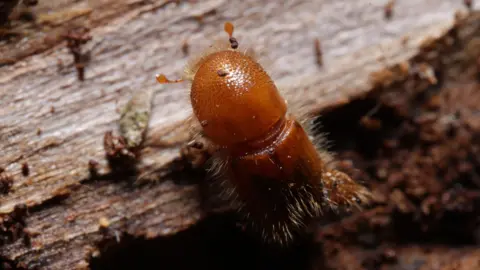 Sean Gallup/Getty Images
Sean Gallup/Getty ImagesIt is smaller than your fingernail, but this hairy beetle is one of the biggest single threats to the UK’s forests.
The bark beetle has been the scourge of Europe, killing millions of spruce trees, yet the government thought it could halt its spread to the UK by checking imported wood products at ports.
But this was not their entry route of choice – they were being carried on winds straight over the English Channel.
Now, UK government scientists have been fighting back, with an unusual arsenal including sniffer dogs, drones and nuclear waste models.
They claim the UK has eradicated the beetle from at risk areas in the east and south east. But climate change could make the job even harder in the future.
The spruce bark beetle, or Ips typographus, has been munching its way through the conifer trees of Europe for decades, leaving behind a trail of destruction.
The beetles rear and feed their young under the bark of spruce trees in complex webs of interweaving tunnels called galleries.
When trees are infested with a few thousand beetles they can cope, using resin to flush the beetles out.
But for a stressed tree its natural defences are reduced and the beetles start to multiply.
“Their populations can build to a point where they can overcome the tree defences – there are millions, billions of beetles,” explained Dr Max Blake, head of tree health at the UK government-funded Forestry Research.
“There are so many the tree cannot deal with them, particularly when it is dry, they don’t have the resin pressure to flush the galleries.”
Since the beetle took hold in Norway over a decade ago it has been able to wipe out 100 million cubic metres of spruce, according to Rothamsted Research.
‘Public enemy number one’
As Sitka spruce is the main tree used for timber in the UK, Dr Blake and his colleagues watched developments on continental Europe with some serious concern.
“We have 725,000 hectares of spruce alone, if this beetle was allowed to get hold of that, the destructive potential means a vast amount of that is at risk,” said Andrea Deol at Forestry Research. “We valued it – and it’s a partial valuation at £2.9bn per year in Great Britain.”
There are more than 1,400 pests and diseases on the government’s plant health risk register, but Ips has been labelled “public enemy number one”.
The number of those diseases has been accelerating, according to Nick Phillips at charity The Woodland Trust.
“Predominantly, the reason for that is global trade, we’re importing wood products, trees for planting, which does sometimes bring ‘hitchhikers’ in terms of pests and disease,” he said.
Forestry Research had been working with border control for years to check such products for Ips, but in 2018 made a shocking discovery in a wood in Kent.
“We found a breeding population that had been there for a few years,” explained Ms Deol.
“Later we started to pick up larger volumes of beetles in [our] traps which seemed to suggest they were arriving by other means. All of the research we have done now has indicated they are being blown over from the continent on the wind,” she added.
 Daegan Inward/Forestry Research
Daegan Inward/Forestry ResearchThe team knew they had to act quickly and has been deploying a mixture of techniques that wouldn’t look out of place in a military operation.
Drones are sent up to survey hundreds of hectares of forest, looking for signs of infestation from the sky – as the beetle takes hold, the upper canopy of the tree cannot be fed nutrients and water, and begins to die off.
But next is the painstaking work of entomologists going on foot to inspect the trees themselves.
“They are looking for a needle in a haystack, sometimes looking for single beetles – to get hold of the pioneer species before they are allowed to establish,” Andrea Deol said.
In a single year her team have inspected 4,500 hectares of spruce on the public estate – just shy of 7,000 football pitches.
Such physically-demanding work is difficult to sustain and the team has been looking for some assistance from the natural and tech world alike.
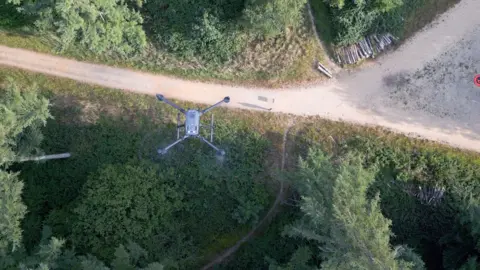 Tony Jolliffe/BBC
Tony Jolliffe/BBCWhen the pioneer Spruce bark beetles find a suitable host tree they release pheromones – chemical signals to attract fellow beetles and establish a colony.
But it is this strong smell, as well as the smell associated with their insect poo – frass – that makes them ideal to be found by sniffer dogs.
Early trials so far have been successful. The dogs are particularly useful for inspecting large timber stacks which can be difficult to inspect visually.
The team is also deploying cameras on their bug traps, which are now able to scan daily for the beetles and identify them in real time.
“We have [created] our own algorithm to identify the insects. We have taken about 20,000 images of Ips, other beetles and debris, which have been formally identified by entomologists, and fed it into the model,” said Dr Blake.
Some of the traps can be in difficult to access areas and previously had only been checked every week by entomologists working on the ground.
The result of this work means that the UK has been confirmed as the first country to have eradicated Ips Typographus in its controlled areas, deemed to be at risk from infestation, and which covers the south east and east England.
“What we are doing is having a positive impact and it is vital that we continue to maintain that effort, if we let our guard down we know we have got those incursion risks year on year,” said Ms Deol.
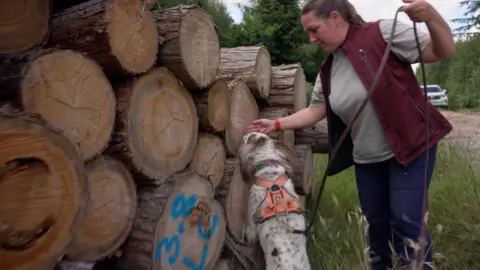 Tony Jolliffe/BBC
Tony Jolliffe/BBCAnd those risks are rising. Europe has seen populations of Ips increase as they take advantage of trees stressed by the changing climate.
Europe is experiencing more extreme rainfall in winter and milder temperatures meaning there is less freezing, leaving the trees in waterlogged conditions.
This coupled with drier summers leaves them stressed and susceptible to falling in stormy weather, and this is when Ips can take hold.
With larger populations in Europe the risk of Ips colonies being carried to the UK goes up.
The team at Forestry Research has been working hard to accurately predict when these incursions may occur.
“We have been doing modelling with colleagues at the University of Cambridge and the Met Office which have adapted a nuclear atmospheric dispersion model to Ips,” explained Dr Blake. “So, [the model] was originally used to look at nuclear fallout and where the winds take it, instead we are using the model to look at how far Ips goes.”
Nick Phillips at The Woodland Trust is strongly supportive of the government’s work but worries about the loss of ancient woodland – the oldest and most biologically-rich areas of forest.
Commercial spruce have long been planted next to such woods, and every time a tree hosting spruce beetle is found, it and neighbouring, sometimes ancient trees, have to be removed.
“We really want the government to maintain as much of the trees as they can, particularly the ones that aren’t affected, and then also when the trees are removed, supporting landowners to take steps to restore what’s there,” he said. “So that they’re given grants, for example, to be able to recover the woodland sites.”
The government has increased funding for woodlands in recent years but this has been focused on planting new trees.
“If we only have funding and support for the first few years of a tree’s life, but not for those woodlands that are 100 or century years old, then we’re not going to be able to deliver nature recovery and capture carbon,” he said.
Additional reporting Miho Tanaka

AI Research
AI replaces excuses for innovation, not jobs
AI isn’t here to replace jobs, it’s here to eliminate outdated practices and empower entrepreneurs to innovate faster and smarter than ever before.

AI Research
AI clamps down on fake science journals
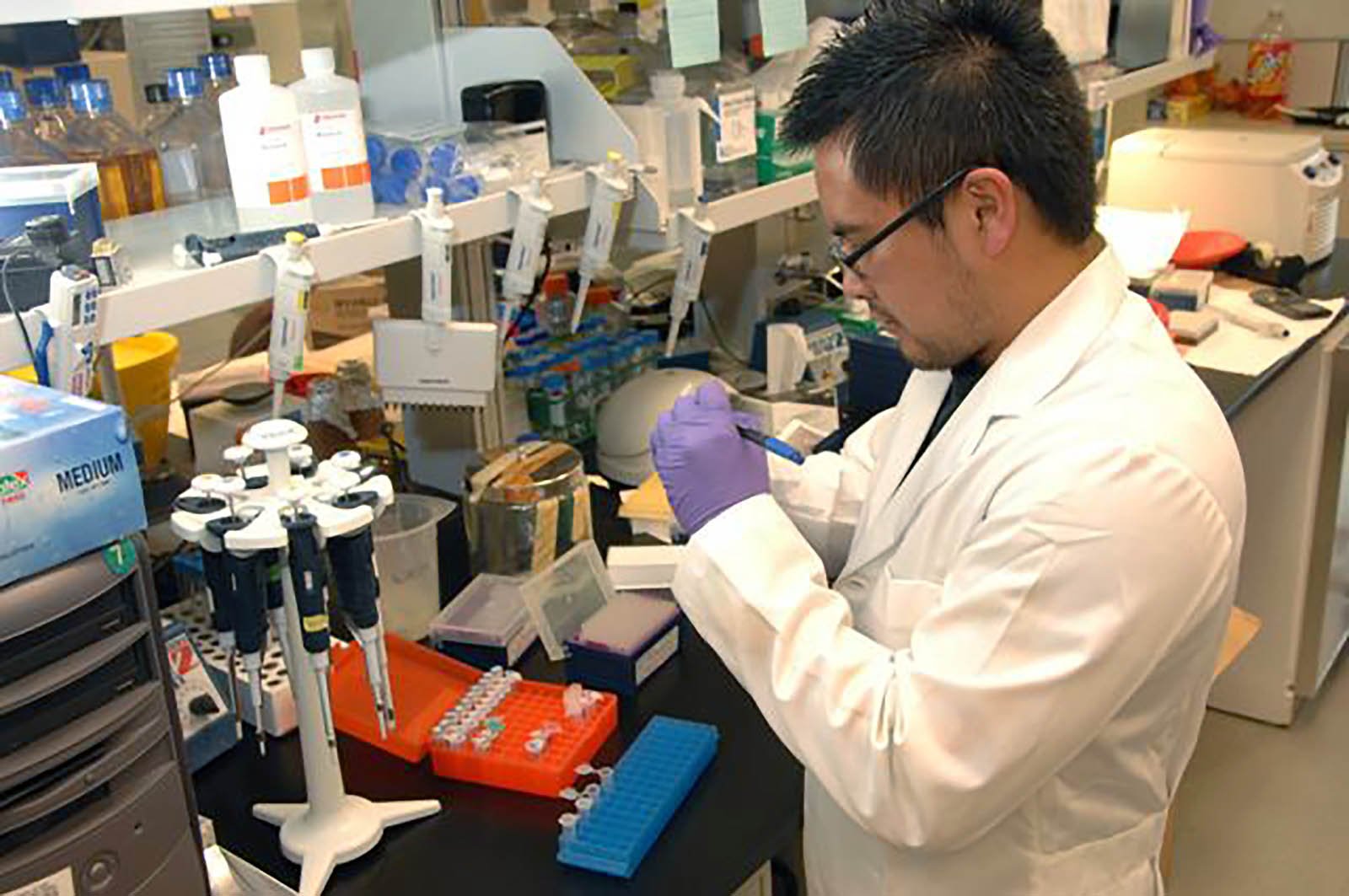
Medical Laboratory Scientist at bench with micropipettes. —
Courtesy U.S. National Institutes of Health (Public Domain)
By deploying a specially configured artificial intelligence, researchers at the University of Colorado Boulder have exposed ‘predatory’ scientific journals—those that trick scientists into paying for publication without proper peer review.
This was achieved by analyzing journal websites for AI-learned red flags like fake editorial boards, excessive self-citation, and sloppy errors. Through these pre-sets. the AI flagged over 1,400 suspicious titles out of 15,200 assessed.
The new AI tool automatically screens scientific journals, evaluating their websites and other online data for certain criteria: Do the journals have an editorial board featuring established researchers? Do their websites contain a lot of grammatical errors?
Many scientists, including this author, receive messages to our email inboxes. These spam messages come from people who purport to be editors at scientific journals, usually ones Acuña has never heard of, and offer to publish his papers — for a hefty fee.
The types of publications are sometimes referred to as “predatory” journals, since they target scientists, convincing them to pay hundreds or even thousands of dollars to publish their research without proper vetting.
Some organisations have long campaigned against such publications. For instance, the Directory of Open Access Journals (DOAJ). Since 2003, volunteers at the DOAJ have flagged thousands of journals as suspicious based on six criteria. (Reputable publications, for example, tend to include a detailed description of their peer review policies on their websites.)
Why does this matter?
In an era when prominent figures (notably Donald Trump) are questioning the legitimacy of science, stopping the spread of questionable publications has become more important than ever before.
Legitimate science
When scientists submit a new study to a reputable publication, that study usually undergoes a practice called peer review. In other words, outside experts read the study and evaluate it for quality.
AI model
The new AI system is not yet publicly accessible; however, the researchers hope to make it available to universities and publishing companies soon.
The application of the AI model appears in the journal Science Advances, titled “Estimating the predictability of questionable open-access journals.”
-
Tools & Platforms3 weeks ago
Building Trust in Military AI Starts with Opening the Black Box – War on the Rocks
-

 Ethics & Policy1 month ago
Ethics & Policy1 month agoSDAIA Supports Saudi Arabia’s Leadership in Shaping Global AI Ethics, Policy, and Research – وكالة الأنباء السعودية
-

 Events & Conferences3 months ago
Events & Conferences3 months agoJourney to 1000 models: Scaling Instagram’s recommendation system
-

 Jobs & Careers2 months ago
Jobs & Careers2 months agoMumbai-based Perplexity Alternative Has 60k+ Users Without Funding
-

 Business1 day ago
Business1 day agoThe Guardian view on Trump and the Fed: independence is no substitute for accountability | Editorial
-

 Funding & Business2 months ago
Funding & Business2 months agoKayak and Expedia race to build AI travel agents that turn social posts into itineraries
-

 Education2 months ago
Education2 months agoVEX Robotics launches AI-powered classroom robotics system
-

 Podcasts & Talks2 months ago
Podcasts & Talks2 months agoHappy 4th of July! 🎆 Made with Veo 3 in Gemini
-

 Podcasts & Talks2 months ago
Podcasts & Talks2 months agoOpenAI 🤝 @teamganassi
-

 Jobs & Careers2 months ago
Jobs & Careers2 months agoAstrophel Aerospace Raises ₹6.84 Crore to Build Reusable Launch Vehicle




















